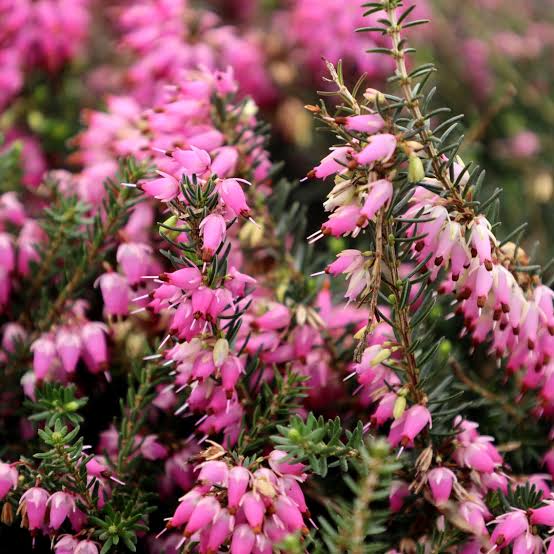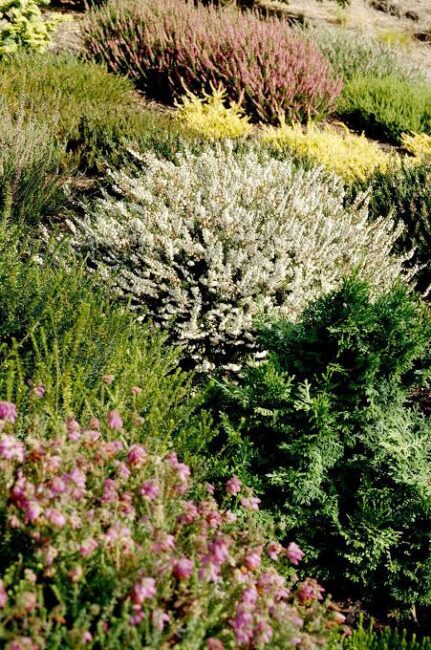Heather flower, with its delicate blooms and vibrant colors, is a true symbol of natural beauty. This enchanting plant, also known as Calluna vulgaris, captivates hearts with its elegance and charm. Native to the moorlands and heathlands of Europe and some parts of North America, Heather flower has a rich cultural history and is revered for its unique qualities. Let’s delve into the fascinating world of Heather and uncover the secrets behind its timeless allure.
Heather flower is characterized by its small, bell-shaped blossoms that adorn slender stems. These exquisite flowers come in an array of shades, ranging from soft pinks and purples to fiery oranges and deep reds. The sheer diversity of colors adds to the allure of Heather, making it a popular choice in gardens, floral arrangements, and even wedding bouquets. Its dainty appearance and intricate structure make it an eye-catching addition to any floral display.
One of the remarkable aspects of Heather flower is its ability to thrive in harsh environments. It has adapted to the challenging conditions of heathlands, where the soil is often acidic and nutrient-poor. Heather’s hardiness and resilience have made it a symbol of perseverance and survival. In folklore, it is believed that Heather flowers protect against bad luck and bring good fortune to those who cultivate them.
Beyond its aesthetic appeal, Heather flower also holds cultural significance. In Scottish traditions, Heather is considered the national flower and holds a special place in the hearts of the people. It is a symbol of Scottish identity, resilience, and loyalty. In fact, Heather is often incorporated into Highland attire, including kilts and tartans, adding a touch of natural elegance to these traditional garments.
Moreover, Heather flower has a long history of medicinal uses. The ancient Celts and Druids recognized its healing properties and used it to treat various ailments. Heather was believed to have antiseptic, diuretic, and calming effects, and was used to ease respiratory conditions, promote relaxation, and support overall well-being. While modern medicine has advanced significantly, Heather’s medicinal legacy continues to inspire herbalists and nature enthusiasts alike.
In addition to its cultural and medicinal significance, Heather flower plays a crucial role in ecological balance. It provides a valuable habitat for wildlife, including bees and butterflies, which are attracted to its nectar-rich blooms. Bees, in particular, are drawn to Heather’s late-season flowering, as it provides them with a vital source of sustenance during times when other flowers may be scarce. By cultivating Heather, we can contribute to the preservation of biodiversity and the delicate balance of nature.
Whether you’re drawn to its captivating beauty, cultural heritage, or ecological value, Heather flower is a treasure worth cherishing. Its delicate petals and alluring colors remind us of the wonders of the natural world and the resilience of life itself. So, next time you encounter a Heather flower, take a moment to appreciate its intricate beauty and the stories it silently tells.
Read Also: Cutworms: How to Identify and Get Rid of Cutworms
History And Significance of Heather Flower

Heather flower has a rich history that spans centuries and is deeply rooted in various cultures and traditions. From ancient folklore to modern symbolism, this delicate bloom has garnered immense significance and holds a special place in the hearts of many.
Historically, Heather flower has been associated with the Celtic people, particularly in Scotland and Ireland. The plant was revered for its beauty and tenacity, as it thrived in the rugged landscapes of the Celtic regions. It was believed to possess protective qualities and was often used in rituals and ceremonies to ward off evil spirits and bring good fortune.
In Scottish culture, Heather holds a particularly prominent role. It is considered the national flower of Scotland and is deeply intertwined with the country’s history and heritage. The iconic purple Heather, known as “Ling” in Scotland, is associated with the Scottish Highlands. It has become a symbol of the rugged beauty and untamed spirit of the Highlands, evoking images of vast moors, misty hillsides, and ancient castles.
Heather flower’s significance in Scotland extends beyond its aesthetic appeal. It is often incorporated into traditional Highland attire, including kilts and tartans. Scottish brides frequently include sprigs of Heather in their bridal bouquets as a symbol of good luck, purity, and a prosperous marriage. The plant’s presence in Scottish folklore and traditions has contributed to its enduring popularity and widespread recognition.
In addition to its cultural symbolism, Heather flower holds medicinal and practical significance. Historically, Heather was used in herbal medicine for its purported healing properties. It was believed to have antiseptic and diuretic qualities, and preparations made from the plant were used to alleviate respiratory ailments, promote relaxation, and even aid in digestion. While modern medicine has progressed, the historical use of Heather in traditional remedies continues to be appreciated.
Furthermore, Heather flower plays a vital ecological role. It thrives in heathlands and moorlands, which are often delicate ecosystems with unique biodiversity. Heather provides food and habitat for various insects, including bees and butterflies, which rely on its nectar for sustenance. Its presence contributes to the balance of these ecosystems, supporting pollinators and maintaining the delicate web of life.
Today, Heather flower remains a beloved symbol of natural beauty, resilience, and cultural identity. Its delicate blooms and vibrant colors continue to inspire artists, gardeners, and nature enthusiasts worldwide. Whether cherished for its visual appeal, revered for its historical significance, or valued for its ecological contributions, Heather flower holds a timeless allure that transcends borders and generations.
However, the history and significance of Heather flower are intertwined with cultural traditions, folklore, and the natural world. Its beauty and symbolism have endured through time, making it a beloved and cherished bloom that represents the spirit of resilience, protection, and the connection between humanity and nature.
Read Also: Categorization, Damages Caused, Diagnosis and Control Methods of Plant Diseases
Complete Growing Guide For Heather Flower

Here is a step-by-step guide to help you cultivate this enchanting flower.
1. Choosing the Right Variety: There are numerous cultivars of Heather, each with its unique characteristics and color variations. Select a variety that suits your climate, soil conditions, and aesthetic preferences. Consider factors such as hardiness, bloom time, and growth habit when making your choice.
2. Selecting an Ideal Location: Heather requires ample sunlight to flourish. Choose a spot in your garden that receives at least six hours of direct sunlight each day. Additionally, Heather prefers well-draining soil with a slightly acidic to neutral pH. Ensure the soil is not waterlogged, as excessive moisture can lead to root rot.
3. Soil Preparation: Prior to planting, prepare the soil by removing any weeds, rocks, or debris. Heather prefers acidic soil with a pH between 4.5 and 6. If your soil is alkaline, you can amend it by adding peat moss or compost to lower the pH. This will help create the ideal growing environment for Heather.
4. Planting Heather: Dig a hole slightly larger than the root ball of the Heather plant. Gently place the plant in the hole, making sure it is at the same level as it was in its original container. Backfill the hole with soil, pressing it firmly around the roots to eliminate any air pockets. Water the plant thoroughly after planting.
5. Watering: Heather plants have shallow root systems and prefer moderate moisture levels. Water your Heather deeply but infrequently, allowing the soil to dry out slightly between watering sessions. Avoid overwatering, as it can lead to root rot. Mulching around the base of the plant can help retain moisture and control weed growth.
6. Pruning and Maintenance: Pruning is essential to maintain the health and shape of your Heather plants. After the blooming period, trim back the faded flowers and any leggy or damaged growth. Pruning will encourage bushier growth and promote better flower production. Additionally, remove any dead or diseased branches as necessary throughout the year.
7. Fertilization: Heather plants are relatively low-maintenance and generally do not require heavy fertilization. However, you can apply a slow-release, acidic fertilizer specifically formulated for acid-loving plants in early spring. Follow the instructions on the fertilizer package for the appropriate application rate.
8. Winter Protection: Heather is generally hardy, but some varieties may require winter protection in colder climates. Apply a layer of mulch around the base of the plants to help insulate the roots and protect them from freezing temperatures. Avoid using heavy mulch that may cause excess moisture retention.
By following these steps and providing the optimal growing conditions, you can successfully grow Heather flower in your garden. With its delicate blooms and enduring beauty, Heather will be a stunning addition, adding a touch of natural charm to your outdoor space. Enjoy the rewards of your efforts as you watch your Heather flourish and brighten your surroundings.
Uses of Heather Flower
Heather flower, with its delicate and vibrant blooms, has been valued for various purposes throughout history. From decorative and ornamental uses to its role in traditional medicine and crafts, Heather has found its place in different aspects of human life. Here are some notable uses of Heather flower.
1. Ornamental Purposes: Heather’s beauty and vibrant colors make it a popular choice for ornamental gardening. The plant’s dainty flowers and evergreen foliage add visual interest and texture to gardens, rockeries, and borders. Heather can be planted in clusters or used as ground cover to create stunning displays. Its ability to thrive in harsh conditions, such as acidic soil and low-nutrient environments, makes it an attractive option for landscaping in challenging climates.
2. Floral Arrangements: Heather flowers are often incorporated into floral arrangements and bouquets. Their delicate blooms and charming colors add a touch of elegance and natural beauty to any floral design. Heather is particularly sought after for rustic, woodland, and cottage-style arrangements, as well as for weddings, where it symbolizes good luck, purity, and a prosperous marriage.
3. Traditional Crafts: Heather has been utilized in traditional crafts for centuries. In Scotland, for instance, Heather stems were historically used to make brooms, thatching for roofs, and even rustic furniture. The stems were woven together to create durable and practical items. Today, artisans continue to incorporate Heather into traditional crafts, including basketry, wreath-making, and floral crafts.
4. Medicinal Uses: Heather has a long history of use in traditional medicine. The plant was believed to possess various healing properties and was used to treat respiratory conditions, promote relaxation, and aid digestion. While modern medicine has evolved, Heather’s historical use in traditional remedies still resonates with herbalists and alternative medicine practitioners.
5. Culinary Applications: In some culinary traditions, Heather has been utilized in food and beverage production. In Scotland, for example, Heather honey is highly prized for its distinctive flavor, which is derived from the nectar collected by bees from Heather flowers. The honey’s unique taste adds depth to culinary creations and is often enjoyed as a gourmet treat.
6. Aromatherapy and Fragrance: Heather flowers have a subtle, pleasant scent that has led to their use in aromatherapy and fragrance production. The essential oil extracted from Heather flowers is known for its soothing and calming properties, making it a popular choice in aromatherapy practices and natural perfumes.
Heather flowers play a crucial role in supporting wildlife and maintaining ecological balance. The nectar-rich blooms attract bees, butterflies, and other pollinators, providing them with a vital food source. By cultivating Heather, you can contribute to preserving biodiversity and supporting the delicate ecosystems in which these plants thrive.
Heather flower’s versatility and aesthetic appeal have made it a cherished resource in various fields. Whether it’s for decorative purposes, traditional crafts, medicinal applications, or ecological preservation, Heather continues to captivate and inspire people around the world. Its enduring charm and multiple uses ensure that this delicate flower will be cherished for generations to come.
Read Also: Unearthing the Impact of Landfills on Our Environment
